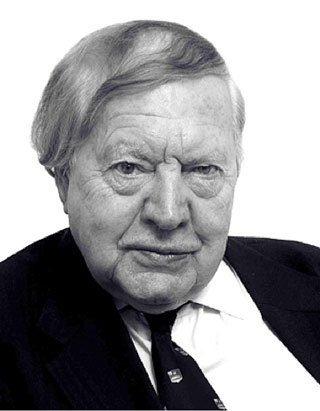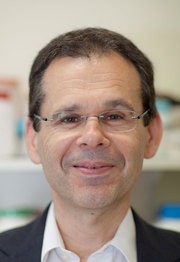Related Research Articles

The Royal Society of Chemistry (RSC) is a learned society in the United Kingdom with the goal of "advancing the chemical sciences". It was formed in 1980 from the amalgamation of the Chemical Society, the Royal Institute of Chemistry, the Faraday Society, and the Society for Analytical Chemistry with a new Royal Charter and the dual role of learned society and professional body. At its inception, the Society had a combined membership of 34,000 in the UK and a further 8,000 abroad. The headquarters of the Society are at Burlington House, Piccadilly, London. It also has offices in Thomas Graham House in Cambridge where RSC Publishing is based. The Society has offices in the United States, on the campuses of The University of Pennsylvania and Drexel University, at the University City Science Center in Philadelphia, Pennsylvania, in both Beijing and Shanghai, China and in Bangalore, India.
Chartered Chemist (CChem) is a chartered status awarded by the Royal Society of Chemistry (RSC) in the United Kingdom, the Royal Australian Chemical Institute (RACI) in Australia, by the Ministry of Education in Italy, the Institute of Chemistry Ceylon (IChemC), Sri Lanka, and the Institute of Chartered Chemists of Nigeria in Nigeria.
Hans Charles Freeman AM, FAA was a German-born Australian bioinorganic chemist, protein crystallographer, and professor of inorganic chemistry who spent most of his academic career at the University of Sydney. His best known contributions to chemistry were his work explaining the unusual structural, electrochemical, and spectroscopic properties of blue copper proteins, particularly plastocyanin. He also introduced protein crystallography to Australia and was a strong advocate for courses to ensure Australian scientists have good access to "big science" facilities. Freeman has received numerous honours, including being elected a Fellow of the Australian Academy of Science (FAA) and appointed a Member of the Order of Australia (AM) by the Australian Government. He was a charismatic lecturer who voluntarily continued teaching well into his formal retirement and imbued his students with a love of science.
Adrien Albert was a leading authority in the development of medicinal chemistry in Australia. Albert also authored many important books on chemistry, including one on selective toxicity.
Lewis Norman Mander,, FAA, FRS was a New Zealand-born Australian organic chemist. He has widely explored the synthesis and chemistry of the gibberellin class of diterpenes over a 20-year period at the Australian National University (ANU). In particular, he studied the effect of these hormones on stem growth and on the reasons why plant undergo bolting during plant development. The July 2004 edition of the Australian Journal of Chemistry was dedicated to Mander on the occasion of his 65th birthday. He retired in 2002 but remained active at the ANU until 2014. In 2018 Mander was made a Companion in the General Division in the Order of Australia which "...is awarded for eminent achievement and merit of the highest degree in service to Australia or humanity at large". In an interview he gave after winning his award, Mander said that his goal was to improve the efficiency of extracting food from plants with the possibility of reducing food shortages in the future.
Martin Gerhardt Banwell, Hon.FRSNZ is an organic chemist specialising in biotransformations and natural product synthesis.
Leonard Francis Lindoy, FAA, is an Australian chemist with interests in macrocyclic chemistry and metallo-supramolecular chemistry, and an Emeritus Professor of Inorganic Chemistry at the University of Sydney and James Cook University. He moved to the University of Sydney in 1996 to take up the departmental chair in inorganic chemistry vacated by Hans Freeman.

Noel Sydney HushAO FRS FNAS FAA FRACI FRSN was an Australian chemist at the University of Sydney.
Michelle Louise Coote FRSC FAA is an Australian polymer chemist. She has published extensively in the fields of polymer chemistry, radical chemistry and computational quantum chemistry. She is an Australian Research Council (ARC) Future Fellow, Fellow of the Royal Society of Chemistry (FRSC) and Fellow of the Australian Academy of Science (FAA).

Frances Separovic is a biophysical chemist and Distinguished Professor Emeritus of Chemistry at the University of Melbourne, where she taught physical chemistry and trained graduate students in her field. She is credited with developing techniques that utilise nuclear magnetic resonance spectroscopy (NMR) to study peptides in lipid bilayers, with applications in the study of the structure of membrane proteins and their effects on membranes. Her more recent research concerns 'the structure and interactions of amyloid peptides from Alzheimer's disease, pore-forming toxins and antibiotic peptides in model biological membranes'.
Dr. Vicki Gardiner FRACI CChem CompIEAust is the current general manager of the Tasmania Division of Engineers Australia.
Margaret Harding is an Australian chemist and educator who is currently Deputy Vice-Chancellor (Research) at The Australian National University (ANU). She is an expert in medicinal and biomolecular chemistry, with special research interests in the areas of antifreeze proteins and ligand-DNA interactions.

Anthony Steven Weiss AM PhD FRSC FTSE FRSN FRACI, FTERM, FBSE is a university researcher, company founder and entrepreneur. He is the leading scientist in human tropoelastin research and synthetic human elastin. He holds the McCaughey Chair in Biochemistry, heads the Charles Perkins Centre Node in Tissue Engineering and Regenerative Medicine, and is Professor of Biochemistry and Molecular Biotechnology at the University of Sydney. His discoveries are on human elastic materials that accelerate the healing and repair of arteries, skin and 3D human tissue components. He is a Fellow of the Royal Society of Chemistry. Weiss is on the editorial boards of the American Chemical Society Biomaterials Science and Engineering, Applied Materials Today (Elsevier), Biomaterials, Biomedical Materials, BioNanoScience (Springer) and Tissue Engineering. He is a biotechnology company founder, promoter of national and international technology development, and has received national and international awards, including the Order of Australia.

David Henry Solomon is an Australian polymer chemist. He is best known for his work in developing Living Radical Polymerization techniques, and polymer banknotes.
Denis Oswald Jordan AO FAA FRACI was an Anglo-Australian chemist with a distinguished career as a researcher and lecturer in Chemistry at both University College Nottingham (1940–53) and the University of Adelaide, where he was Angas Professor of Chemistry from 1958 to 1982. Jordan also served as president of Australian Institute of Nuclear Science and Engineering from 1958 to 1962, and Royal Australian Chemical Institute from 1978 to 1979.
Mary Jean Garson is an organic chemist and academic in Australia. She currently works for the University of Queensland.
Robert Harold (Robin) Stokes FAA (1918–2016) was an Australian chemist and Foundation Professor of Chemistry at the University of New England, from 1955 to 1979. His research interests included solution thermodynamics and electrolytes.
Elizabeth Joy New AM SFHEA FRSC FRACI FRSN is an Australian chemist and Professor of the School of Chemistry, University of Sydney. She won the 2018 Australian Museum 3M Eureka Prize.
Jonathan Baell is trained as an Australian medicinal chemist and is currently executive director, early leads chemistry at Lyterian Therapeutics in San Francisco. Prior to this, he was a research professor in medicinal chemistry at the Monash Institute of Pharmaceutical Sciences (MIPS), the director of the Australian Translational Medicinal Chemistry Facility and a Chief Investigator at the ARC Centre for Fragment-Based Design. He was President of the International Chemical Biology Society 2018-2021 and is currently chair of the board. His research focuses on the early stages of drug discovery, including high-throughput screening (HTS) library design, hit-to-lead and lead optimization for the treatment of a variety of diseases, such as malaria and neglected diseases.

Deanna Michelle D'Alessandro is an Australian chemist who is a Professor and Australian Research Council Future Fellow at the University of Sydney. Her research considers fundamental aspects of electron transfer in molecular coordination complexes and in nanoporous materials, and the development of metal–organic frameworks for environmental applications including carbon dioxide capture and conversion.
References
- ↑ Australian Science at Work RACI entry
- 1 2 3 Hügel, Helmut (2007). "Royal by name, real by nature: RACI at 90". Chemistry in Australia. 74 (10). Melbourne: Royal Australian Chemical Institute. Inc: 24–25.
- ↑ Federation of Australian Scientific and Technological Societies
- ↑ Federation of Asian Chemical Societies
- ↑ "Green and Sustainable Group". raci.org.au. Retrieved 25 February 2023.
- 1 2 "Membership Types". Royal Australian Chemical Institute. 2018.
- ↑ "RACI Fellow (FRACI)". Royal Australian Chemical Institute. 2018.
- ↑ "Chemistry in Australia magazine". chemaust.raci.org.au. Retrieved 17 April 2018.
- ↑ Australian Journal of Education in Chemistry
- ↑ "H. G. Smith Memorial Award". raci.org.au. Retrieved 1 May 2018.
- ↑ "Past Officers & Award Winners". raci.org.au. 2016. Retrieved 1 May 2018.
- ↑ Cornforth Medal
- ↑ "Leighton Memorial Medal – The Royal Australian Chemical Institute Incorporated". raci.org.au. Retrieved 26 March 2017.